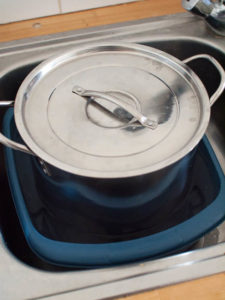Cooling and Pitching Yeast
To get the beer ready for fermentation we need to start cooling the wort down. Yeast require a specific temperature range to thrive in. Ale yeasts need be kept around 16°C – 24°C any colder and the yeast will begin to hibernate and not ferment the beer, warmer and the yeast will produce harsh flavours and at much warmer temperatures the yeast cells will die.
Our aim is to cool the beer as quickly as possible. There are a couple of reasons to do this, one is that oxidation can occur when cooled over a long period as well as allowing the possibility of bacteria contaminating the wort which would completely ruin the batch. Also as the beer cools slowly it produces a sulfur compound that will remain in the finished beer creating unwanted off-flavours.

This really is as easy as it sounds. Obviously if you boil your wort in a metal pot then it will cool a lot quicker due to conduction.
Sit your vessel with the lid on if you have one in a bath of ice cold water. You can of course throw a load of ice into the water bath to speed up cooling and you will notice after 5 minutes or so the water bath will be noticeably warm. It’s a good idea to stir this water to even out the temperature. Also you may find you will need to change the water several times to get it to around room temperature. Using this method you can quickly cool the beer to room temperature within a fairly short period of time.
Once the wort is cooled it can be added to the fermenter. Remove hops and debris by running the beer though a sanitised strainer into the fermenter. The resulting amount can be topped up to the full desired brew amount(for the recipes below this will be 18 litres). Remember this action of topping up the fermenter will also cool the beer too.
Pouring and topping up the beer in the fermenter should introduce enough oxygen that the yeast need to ferment the beer. At this stage take a final temperature check and you can now add the yeast to the wort simply by sprinkling over the surface. Seal the fermenter with the lid and insert the airlock. That’s the brewday over, it’s now time to sit back and wait for the yeast to do its thing and ferment out the beer.
